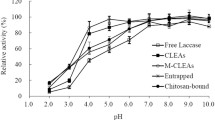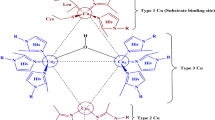Abstract
Laccase from Coriolopsis gallica UAMH8260 was immobilized on activated agarose and tested for repeated decolorization of industrial dyes. Immobilized enzyme retained 85% of the initial activity after 10 cycles, and 70% after 3 months of intermittant use in the decolorization of Reactive Blue 198 dye. Free laccase decolorized 13 of 38 industrial dyes tested but, in the presence of 1 mM 1-hydroxybenzotriazole as a free radical mediator, the enzyme decolorized 26 of the 38 dyes increasing both the range and rate of decolorization. Immobilized laccase showed a higher thermal stability at 70 °C than free enzyme but no increased resistance to organic solvents.
Similar content being viewed by others
References
Archibald F, Paice MG, Jurasek L (1990) Decolorization of Kraft bleachery effluent chromophores by Coriolus (Trametes) versicolor. Enzyme Microbiol. Techn. 12: 846–853.
Arjmand M, Sandermann H (1985) Mineralization of chloraniline/lignin conjugates and of free chloranilines by white rot fungus Phanerochaete chrysosporium. J. Agric. Food Chem. 33: 1055–1060.
Beaudette LA, Davies S, Fedorak PM, Ward OP, Pickard MA (1998) Comparison of biodegradation and mineralization as methods formeasuring loss of selected polychlorinated biphenyl congeners in cultures of four white rot fungi. Appl. Env. Microbiol. 64: 2020–2025.
Bogan BW, Lamar RT (1996) Polycyclic aromatic hydrocarbon-degradation capabilities of Phanerochaete leavis HHB-1625 and its extracellular ligninolytic enzymes. Appl. Env. Microbiol. 62: 1597–1603.
Bourbonnais R, Paice MG (1990) Oxidation of non-phenolic substrates. An expanded role for laccase in lignin biodegradation. FEBS Lett. 267: 99–102.
Brown DH, Hitz HR, Shafer L (1981) The assessment of the possible inhibitory effect of dyestuffs on aerobic wastewater bacteria. Experience with a screening test. Chemosphere 10: 245–261.
Chivukula M, Renganathan V (1995) Phenolic azo dye oxidation by laccase from Pyricularia oryzae. Appl. Env. Microbiol. 61: 4374–4377.
Chung K-T, Stevens E (1992) The reduction of azo dyes by the intestinal microflore. Crit. Rev. Microbiol. 18: 175–190.
Cripps C, Bumpus JA, Aust SD (1990) Biodegradation of azo and heterocyclic dyes by Phanerochaete chrysosporium. Appl. Env. Microbiol. 56: 1114–1118.
Damkus T, Schneider P, Bech L, Heinzkill M (1996) Coprinaceae laccases International Pat. WO96/06930A1 (March 7, 1996).
Davis S, Burns RG (1992) Covalent immobilisation of laccase on activated carbon for phenolic effluent treatment. Appl. Microbiol. Biotechnol. 37: 474–479.
EPA (US Environmental Protection Agency) (1996) Best Management Practices for Pollution Prevention in the Textile Industry, EPA, Office of Research and Development, U.S. EPA/625/R-96/004.
Gorontzy T, Drzyga O, Kahl MW, Bruns-Nagel D, Breitung J, von Loew E, Blotevogel KH (1994) Microbial degradation of explosives and related compounds. Crit. Rev. Microbiol. 20: 265–284.
Hutzinger O (1980) The Handbook of Environmental Chemistry, Vol. 3, Part A. Berlin, Heidelberg: Springer-Verlag, 188 pp.
Johannes C, Majcherczyk A, Huttermann A (1996) Degradation of anthracene by laccase of Trametes versicolor in the presence of different mediating substrate compounds. Appl. Microbiol. Biotechnol. 46: 313–317.
Kirby N, McMullan G, Marchant R (1995) Decolourisation of an artificial textile effuent by Phanerochaete chrysosporium. Biotechnol. Lett. 178: 761–764.
Kulkarni SV, Blackwell CD, Blackard AL, Stackhocese CW, Alexander MW (1985) Textile dyes and dyeing equipment, classification, properties and environmental aspects. US Environmental Protection Agency, Research Triangle Park, NC, EPA-600/2–85/010.
Kullman SW, Matsumura F (1996) Metabolic pathways utilized by Phanerochaete chrysosporium for degradation of cyclodiene pesticide Endosulfan. Appl. Environ. Microbiol. 62: 593–600.
Luterek J, Gianfreda L, Wojtas-Wasilewska M, Cho NS, Rogalski J, Jaszek M, Malarczyk E, Staszczak M, Fink-Boots M, Leonowicz A (1998) Activity of free and immobilized extracellular Cerrena unicolor laccase in water miscible organic solvents. Holzforschung 52: 589–595.
Majcherczyk A, Johannes C, Huttermann A (1998) Oxidation of polycyclic aromatic hydrocarbons (PAH) by laccase of Trametes versicolor. Enzyme Microbiol. Technol. 22: 335–341.
Michaels GB, Lewis DL (1985) Sorption and toxicity of azo and triphenylmethane dyes to aquatic microbial populations. Env. Toxicol. Chem. 4: 45–50.
Milstein O, Nicklas B, Huttermann A (1989) Oxidation of aromatic compounds in organic solvents with laccase from Trametes versicolor. Appl. Microbiol. Biotechnol. 31: 70–74.
Milstein O, Huttermann A, Majcherczyk A, Schulze K (1993) Transformationof lignin-related compounds with laccase in organic solvents J. Biotechnol. 30: 37–47.
Muñoz G, Gillén F, Martínez AT, Martínez MJ (1997) Laccase isoenzymes of Pleurotus eryngii: characterization, catalytic properties, and participation in activation of molecular oxygen and Mn2+ oxidation. Appl. Env. Microbiol. 63: 2166–2174.
Ollikka P, Alhonmaki K, Leppanen V-M, Glumoff T, Raijola T, Suominen Y (1993) Decolorization of azo, triphenyl methane, heterocyclic, and polymeric dyes by lignin peroxidase isoenzymes from Phanerochaete chrysosporium. Appl. Env. Microbiol. 59: 4010–4016.
Pagga U, Brown D (1986) The degradation of dyestuffs. Part II. Behavior of dyestuffs in aerobic biodegradation tests. Chemosphere 15: 479–491.
Paszczynski A, Crawford RL (1991) Degradation of azo compounds by ligninase from Phanerochaete chrysosporium: involvement of veratryl alcohol. Biochem. Biophys. Res. Commun. 178: 1056–1063.
Pickard MA, Roman R, Tinoco R, Vazquez-Duhalt R (1999) Polycyclic aromatic hydrocarbon metabolism by white rot fungi, and oxidation by Coriolodopsis gallica UAMH 8260 laccase. Appl. Env. Microbiol. 65 (in press).
Reid I, Paice MG (1994). Biological bleaching of kraft pulps by white-rot fungi and their enzymes. FEMS Micobiol. Rev. 13: 369–375.
Rodríguez E, Pickard MA, Vazquez-Duhalt R (1999) Industrial dye decolorization by laccases from lignolytic fungi. Curr. Microbiol. 38: 27–32.
Rogalski J, Dawidowicz A, Jozwik E, Leonowicz A (1999) Immobilization of laccase from Carrena unicolor on controlled porosity glass J. Mol. Catalysis B: Enzymatic 6: 29–39.
Ruckenstein E, Wang X-B (1994) Production of lignin peroxidase by Phanerochaete chrysosporium immobilized on porous poly(styrene-divinylbenzene) carrier and its application to the degrading of 2-chlorophenol. Biotechnol Bioeng. 44: 79–86.
Sasek V, Volfova O, Erbanova P, Vyas BRM, Matucha M (1993) Degradation of PCBs by white rot fungi, methylotrophic and hydrocarbon utilizing yeasts and bacteria. Biotechnol. Lett. 15: 521–526.
Schliephake K, Lonegran GT (1996) Laccase variation during dye decolourisation in a 200 L packed-bed bioreactor. Biotechnol. Lett. 18: 881–886.
Shin KS, Oh IK, Kim CJ (1997) Production and purification of Remazol Brilliant Blue R decolorization peroxidase from the culture filtrate of Pleurotus ostreatus. Appl. Env. Microbiol. 63: 1744–1748.
Takada S, Naksamura M, Matsueda T, Kondo R, Sakai K (1996) Degradation of polychlorinated dibenzo-p-dioxins and polychlorinated dibenzofurans by the white rot fungus Phanerochaete sordida YK-624. Appl. Env. Microbiol. 62: 4323–4328.
Vasdev K, Kulad RC, Saxena RK (1995) Decolorization of triphenylmethane dyes by the bird's nest fungus Cyathus bulleri. Curr. Microbiol. 30: 268–272.
Author information
Authors and Affiliations
Rights and permissions
About this article
Cite this article
Reyes, P., Pickard, M.A. & Vazquez-Duhalt, R. Hydroxybenzotriazole increases the range of textile dyes decolorized by immobilized laccase. Biotechnology Letters 21, 875–880 (1999). https://doi.org/10.1023/A:1005502906890
Issue Date:
DOI: https://doi.org/10.1023/A:1005502906890




